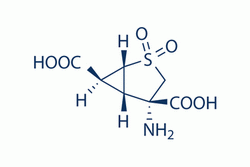| Description: |
LY404039 is an inhibitor for mGluR1(Ki=149 nM) and mGluR2(Ki= 92 nM), which can also inhibit dopamine receptor.Metabotropic glutamate (mGlu) receptors have been shown to mediate a number of behaviors including emotionality and responsivity to stress as demonstrated by efficacy in preclinical and clinical studies. |
| In Vivo: |
LY404039 attenuated amphetamine- and phencyclidine-induced hyperlocomotion (3-30 and 10 mg/kg, respectively). LY404039 (3-10 mg/kg) inhibited conditioned avoidance responding. LY404039 also reduced fear-potentiated startle in rats (3-30 microg/kg) and marble burying in mice (3-10 mg/kg), indicating anxiolytic-like effects. Importantly, LY404039 did not produce sedative effects or motor impairment as measured by rotarod performance and lack of escape failures in the conditioned avoidance task (at doses up to 30 and 10 mg/kg, respectively). LY404039 (10 mg/kg) also increased dopamine and serotonin release/turnover in the prefrontal cortex [3].Clinical trial: An Absolute Bioavailability Study of LY-2140023 and LY-404039 in Healthy Subjects Using the Intravenous Tracer Method. Phage1 |
| In Vitro: |
Similar to LY354740, LY404039 is a nanomolar potent agonist at recombinant human mGlu2 and mGlu3 receptors (K(i) = 149 and 92, respectively) and in rat neurons expressing native mGlu2/3 receptors (Ki = 88). LY404039 is highly selective for mGlu2/3 receptors, showing more than 100-fold selectivity for these receptors, versus ionotropic glutamate receptors, glutamate transporters, and other receptors targeted by known anxiolytic and antipsychotic medications[1]. |






















